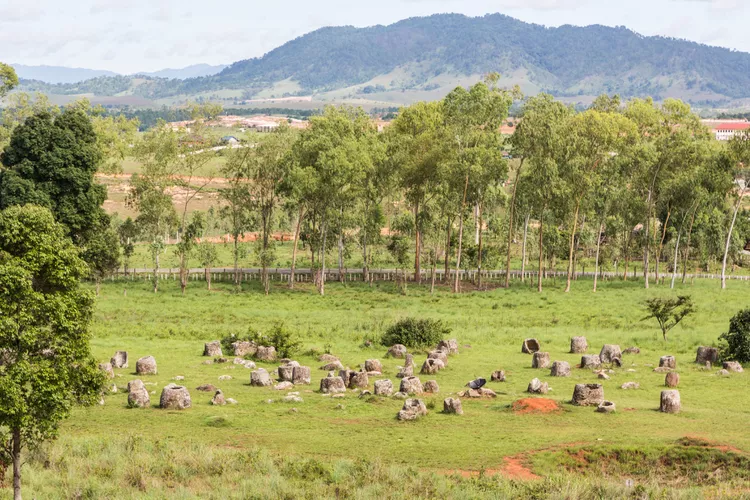Explore the Mysterious Plain of Jars in Laos
The Plain of Jars in central Laos is one of Southeast Asia’s most mysterious and misunderstood prehistoric places. Around 90 sites scattered across miles of rolling landscape contain thousands of large stone jars, each weighing several tons. Despite the best efforts of archaeologists, the origin and reason for the Plain of Jars remain a mystery.
The vibe around the Plain of Jars is eerie and somber, comparable to the same feeling people report at Easter Island or Stonehenge. Standing among the enigmatic jars acts as a sobering reminder that human beings do not have all the answers. Only one enormous jar, located at the site closest to town and most visited by tourists, has a carved relief of a human being with knees bent and arms reaching to the sky.
History of the Plain of Jars
Only the recent discovery of human remains near the Plain of Jars has allowed the site to be dated. Archaeologists think the jars were carved with iron tools and date them back to the Iron Age, around 500 B.C. Nothing is really known about the culture that painstakingly carved the stone jars.
Theories about the uses of the jars range widely; the leading theory is that the jars once held human remains, while local legend claims that they were used to ferment lao lao rice wine. Another theory suggests that the jars were utilized to collect rainwater during the monsoon season.
In 1930, French archaeologist Madeleine Colan conducted research around the Plain of Jars and discovered bones, teeth, pottery shards, and beads. Unfortunately, war and politics prevented further excavation around the jars until 1994, when Professor Eiji Nitta was able to conduct more research on the site. Millions of unexploded objects from the Vietnam War remain in the vicinity, making excavation a slow and dangerous process. Many of the jars were split or knocked over by concussion waves caused by intense bombing during the war.
Visiting the Plain of Jars in Laos
The site most frequented by tourists is the one closest to the town of Phonsavan, known simply as “Site 1.” This is the first stop on the plain and a must-see for observing the only decorated jar found so far.
Although visitors may be approached by guides and touts in Phonsavan selling tours, the ideal way to experience the Plain of Jars is at your own pace, allowing you to reflect upon the site’s mysteries. Fortunately, only a small trickle of tourists tend to make the journey out to see the jars.
Once the threat of unexploded objects is minimized, Laos intends to turn the Plain of Jars into a UNESCO World Heritage Site, which could significantly increase tourism.
Note: The stone disks on the ground are often mistaken for the lids to the jars; however, it was concluded that the disks are actually burial markers.
Jar Sites at the Plain of Jars
Out of the 90 jar sites, only seven have been declared safe enough for tourists to visit:
- Site 1: Closest to town and receives the most visitors, yet it is not the best representation of the Plain of Jars.
- Site 2: Accessible from Site 1 by motorbike or tuk-tuk, followed by an easy hike to Site 3.
- Site 52: The largest known site containing 392 jars, rarely visited and can only be reached by foot. Always stay on the signed paths when walking between jar sites.
Warning: While the picturesque and serene landscape of the Plain of Jars may seem inviting, it is crucial to remember that Laos is the most bombed country, per capita, in the world; an estimated 30 percent of all munitions dropped remain unexploded and still pose a threat. Always stay on marked, well-worn paths when walking between jar sites.
While navigating through the site, look out for these artifacts and special attractions:
- Stone jars broken apart by shock waves caused by carpet bombing in the 1960s.
- Stone disks on the ground used as burial markers.
- Shells, fighting positions, destroyed tanks, and other war scrap left behind.
- “Craters” restaurant and the Mines Advisory Group shop located nearby in Phonsavan.
Getting There
The small town of Phonsavan serves as the capital of Xieng Khouang province and is the usual base for visiting the Plain of Jars.
By Plane: Lao Airlines operates several flights each week from Vientiane to Phonsavan’s Xiang Khouang Airport (XKH).
By Bus: Daily buses run between Phonsavan and Vang Vieng (eight hours), Luang Prabang (eight hours), and Vientiane (eleven hours).





